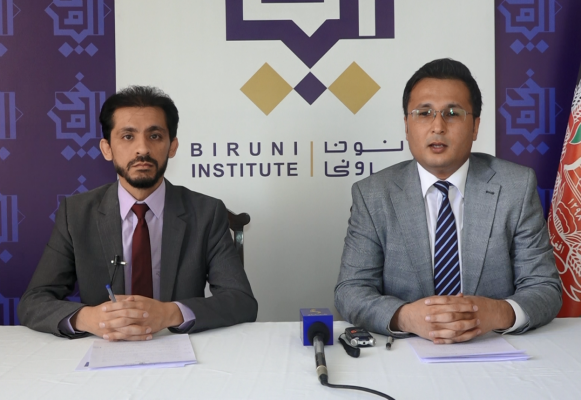Biruni Insitute launched its latest Afghanistan Economic Outlook (AEO) in a media conference on July 27th. It is the second issue in the series that was launched by the Institute in April this year.
The July edition of the AEO reports on economic developments in the first half of 2020, including inflation, revenues, expenditures, and trade, and revises Biruni Institute’s macroeconomic projections for 2020-2022. It also produces forecast for the impact of COVID-19 on unemployment in Afghanistan. This issue of the AEO included two in-depth topics: 1) “COVID-19 Response Programs: Food versus Cash”; and 2) “Wheat Prices Vulnerability to Trade Shocks”.
Nazir Kabiri, Executive Director, and Dr. Omar Joya, Head of Research at the Biruni Institute, presented the following key highlights of the report in the media event:
- COVID-19 pandemic has strongly affected economic activities in the country. The economy is projected to contract by 8.2 percent in 2020, before embarking on a recovery phase by Spring 2021.
- Exports dropped to merely US$ 32.7 million (Afs 2.5 billion) in the second quarter of 2020, compared to $204 million in Q1-2020 or compared to $143 million in Q2-2019.
- Inflation increased from 3.8 percent in January 2020 to 6.4 percent in June 2020. This was mainly driven by food prices inflation which increased from 6 percent to 12.6 percent over the period.
- Revenues in the first half of the year were nearly 17 percent lower than in the same period in previous year. This has opened up a budget deficit of Afs 40 billion (about $525 million) for this year, despite frontloading of donor resources.
- An 8-percent economic contraction increases unemployment rate from 23.9 percent in 2017 to 37.9 percent in 2020. If “underemployment” is also taken into consideration, the figure would be as much as 53.5 percent. In nominal terms, this means that nearly 4.8 million people will be either unemployed or under-employed by the end of 2020, which is an increase of 1.5 million people compared to the 2017 levels.
- The need for an emergency support program to households is enormous, and the government’s approach to mobilize $300 million required for the REACH project by reallocating resources from the existing development portfolio is justified. However, the type and the structure of the program, which currently relies on in-kind distribution of food, needs to be seriously reconsidered for the reasons of efficiency, effectiveness, value-for-money, and transparency.
The July edition of the AEO can be downloaded from this page.



